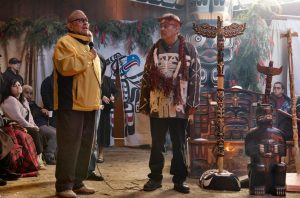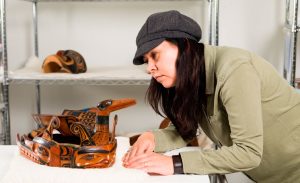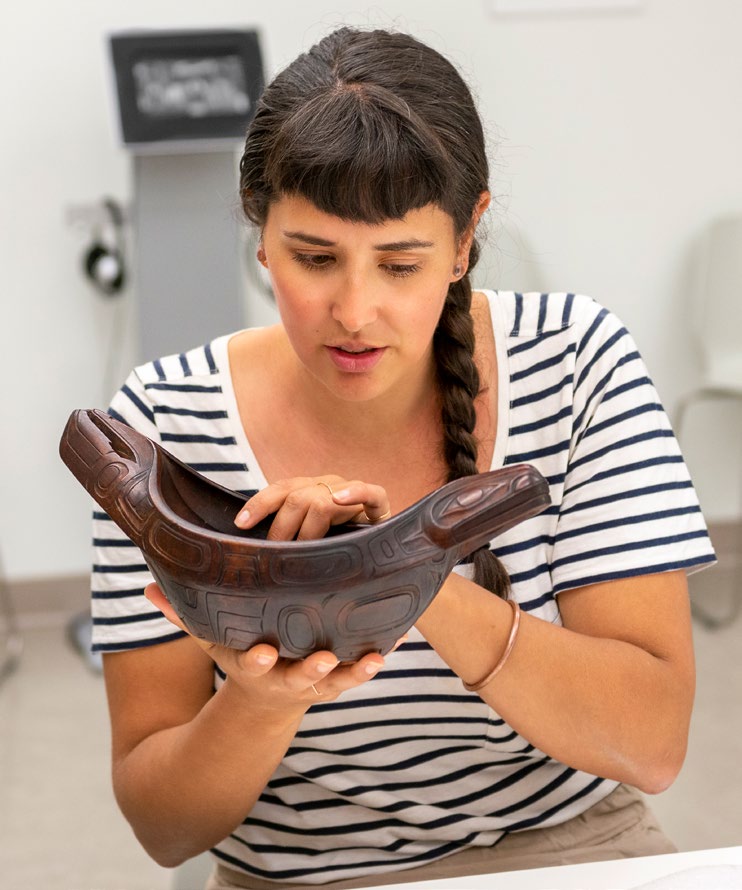The Newsroom
Q&A: Karen Duffek & Jordan Wilson, authors of “Where the Power Is”
Where the Power Is: Indigenous Perspectives on Northwest Coast Art, by Karen Duffek, Bill McLennan (1948–2020), and Jordan Wilson, brings together over eighty contemporary Indigenous knowledge holders with extraordinary works of historical Northwest Coast art. First Nations Elders, artists, scholars, and other community members visited the Museum of Anthropology at the University of British Columbia to connect with these objects, learn from the hands of their ancestors, and share their thoughts and insights on how these belongings transcend the category of “art” or “artifact” to embody vital ways of knowing and being in the world.
In this interview conducted via email with Michael Leyne, the book’s editor, Karen and Jordan discuss their experiences crafting the book, the worlds of knowledge that the commentators and objects within speak to, and vital questions the book asks about relationships among museums, Indigenous communities, and settler institutions today and in the future.
Most of the commentators in the book visited MOA to encounter these objects in person and share their thoughts, which collectively offer a vast range of knowledge, ideas, and perspectives, from technical appreciations of the craftsmanship on display to pointed political insights to moving family memories. I imagine those visits must have been a lot of fun, and also quite intense at times. Looking back, are there experiences that stand out as especially affecting or surprising?
Jordan: As museum professionals, it can almost become easy to take the collections for granted. When we crammed into the recording booth with a participant and a selection of objects, the objects’ presence became amplified. I think every encounter had a similar energy.
Karen: One such memorable moment was when we were recording a conversation with Chief Robert Joseph, looking at some Kwakwaka’wakw belongings with him. He spoke about the role of younger generations in the potlatch today, and reflected on the continuities but also the need to accept change in these important ceremonies. Then Jo Billows, a young Homalco spoken-word poet, joined us in the room and recorded their spoken-word piece, “Red Lineage.” Chief Joseph, who was meeting Jo for the first time, was moved to tears by the words in that poem tying generations of “rebellious daughters” to the idea of recurring patterns, and to the hope that Jo was articulating for the future. Amazing moments like this were generated around a visit with ancestral baskets and regalia.
The book originated from In a Different Light: Reflecting on Northwest Coast Art, an ongoing exhibition you curated with Bill, which opened at MOA in 2017. In translating or extending the project into book format, what were some of the challenges and opportunities that arose? Does the change of title reflect a shift in your perspectives along the way?
Jordan: It was interesting extending the project but within a different set of constraints, although in both instances we had to fight the urge to keep adding both objects and people’s voices. The book allowed for more information about each object to be shared, and of course, for many more perspectives to be part of the conversation. The new title emphasizes that the project is about more than looking, and the multiple forms of power or power relations that intersect both in the objects themselves and at the site of the museum.
Karen: It wasn’t so much a “shift” as wanting to use all the potential of a book, and the time that readers would be able to spend with it, to more strongly reinforce the intention underlying the exhibit: to focus attention on some extraordinary historical objects and belongings, and on the diverse ways that Indigenous people now connect to and think about them. To physically visit an exhibit, of course, offers an experience of sharing a space with the objects and being immersed in the audio (the recorded commentaries); the gallery space itself features lighting that literally presents the objects “in a different light,” reinforcing the potential of seeing and thinking about the objects differently. But the book has allowed us to offer a further and expanded depth of engagement.
The title comes from a quote by Dempsey Bob, where he describes the visceral sensation of encountering these objects, or belongings, and the power embedded within them. What are some of the other ways the book highlights or addresses various forms of power and their shifting locations?
Karen: Dempsey Bob is recalling the moment of opening a drawer in a museum and seeing the robe that still carries so much power because of its long history of use. This book’s photographs don’t hide the fact that the commentators were engaging with ancestral objects at the site of the museum; their words reflect in multiple ways the challenges, but also the potentials, that this current reality means for Indigenous artists and community members. Indigenous artists and researchers working with historical collections in museums today are strengthening and creating new relationships with their ancestral materials; that process requires a new relationship with the institutions, as well.
Jordan: Numerous commentators speak to the complexities of historical Northwest Coast “art,” objects, and belongings existing in museum collections, the history of unequal power dynamics between Indigenous peoples and settler colonial institutions and collectors that facilitated the displacement of objects from community, and how these relationships persist today. That said, a common thread throughout the commentaries is the agency of Indigenous ancestors who made, sold, or traded these works in a rapidly changing world, and the potential that these works have for restoring and reclaiming cultural and political systems.
One of the goals of the project was to show the ways in which these objects live today as more than artworks to be admired for their aesthetic qualities. Are there certain objects in the book that you personally came to see in a different light through this process?
Karen: The objects and belongings that have been brought back into ceremony—like several chiefly headdresses and a talking stick danced at recent potlatches in Alert Bay—are especially powerful in showing the vitality of connection, the way that museum-held objects can be activated as they continue to function and be connected to the families that have rights to the names and privileges represented. There are also objects like the beautifully carved “soul catchers” that are so widely admired as artworks in museums and collectors’ circles, and yet for the artists commenting on them in the book they are almost unknowable, as they are no longer in use and represent a kind of specialized knowledge and power. These spiritual tools raised important questions and conundrums about what can be learned from looking at them today, and whether we should even be looking at them.
Jordan: There are so many instances that it is difficult to choose. As a non-artist and particularly a non-carver, I was often fascinated by how knowledgeable and highly skilled artists would express their deep appreciation of the technical mastery in particular objects, which was evident in subtle or small details that they would point out. However, it was often the philosophical or conceptual questions that would shift not only how I looked at one work, but also many others. In discussing a carved dagger pommel, Haa’yuups observed the way in which multiple creatures existed within the same space in ways that defy the presumed limits of physics; he asked a question along the lines of, “If you believe this is possible, how does that affect how you behave?” Of course, so much of Northwest Coast art breaks physical boundaries and thus speaks to distinct ways of understanding and being in the world.
Skeena Reece talks about the urgent need to connect Indigenous communities and people to these objects, saying “It’s an emergency, right?” For readers who may be more accustomed to thinking of a museum in terms of conservation and display, can you discuss what’s at stake when you’re working with communities and individuals on a project like this?
Karen: A project like this is seemingly focused on the past, but in reality it’s about the future. The museum’s challenge is to not just publish the words and forget them, but to act on them: working with community members to support different forms of community access to the collections, to create more proactive repatriation policies and other forms of return, to support Indigenous interns and researchers, to use the museum’s leverage to bring home more historical pieces so that community members can visit with and study them, to support and share vital research on the historical art forms. Museums, as Raymond Boisjoly says in the book, carry a lot of colonial weight that needs to be redressed, but they’re what we have. They have built and preserved collections so that those objects could survive into the future. A big question now is, what might that future look like? The commentators in this book have some strong and provocative answers.
Amid many powerful and moving comments on the resurgence to which these treasures are contributing, many contributors also speak to the devastation of Canada’s ongoing settler-colonialism and the dire need for reconciliation, or “reparation and conciliation,” as Jisgang—Nika Collison frames it. How is, say, a nineteenth-century carved bowl connected to contemporary discourses around decolonization, reconciliation, and repatriation?
Jordan: I think all of our contributors want non-Indigenous readers, particularly those occupying the territories of their communities, to understand that the objects and belongings featured in the book are connected to living, dynamic traditions, and also distinct political orders connected to specific people and places. From my observation, they are pushing back against Northwest Coast art being a consumable commodity (what Dr. Sarah Hunt refers to as a normative experience); they want readers and viewers to reflect on their own positions and how they are implicated in Indigenous-settler relations rather than just passively admire beautifully made objects.
Karen: I love the brief comment by Tsēmā Igharas who admires a Haida seal-shaped bowl and tells us that she made one too, at carving school, and always takes it to potlatches and feasts. Inspired by the old form, she has made it new, functional, and a part of her own life. Reclamation in action.
Many of the objects featured in the book came to MOA through a private donation. As Canadians learn more about the ruptures caused by Indian Residential Schools and other tools of settler colonialism, and the vital role that these belongings can play in restoring Indigenous practices, are these types of donations becoming more common? Does the “art” market share the sense of urgency that Skeena Reece identifies, and that is increasingly informing institutional relationships with these objects and their originating communities?
Jordan: Unfortunately, so many of the objects that have circulated in the private market have been stripped of their histories, so it is often incredibly difficult to ascertain their origins. In turn, this lack of metadata makes it challenging to return objects home to their communities. Objects being donated to an institution like MOA feels like an imperfect interim solution; hopefully, though, by returning them to the Northwest Coast—from Europe, or the Eastern coast—they will be that much closer to reuniting with their communities of origin. As repatriation becomes increasingly urgent, so too does the role of institutions and their staff in facilitating research and reconnection.
You mentioned a while ago how the participants and other Indigenous readers will be excited to see how members of other communities are reconnecting to and reviving the knowledge embodied in these objects. Another important readership for the book I think is non-Indigenous readers, who, as Tʼayagilaʼogwa—Marianne Nicolson notes, need to “meet us [Indigenous peoples] further in” if there’s to be progress towards meaningful reconciliation. How do you hope or anticipate the book may resonate with these different audiences?
Karen: We have indeed seen a lot of excitement on the part of contributors and readers on the centring of diverse Indigenous voices, and our attempt to address upfront the challenges of ongoing colonial legacies around the institutionalization of Northwest Coast historical art. We anticipate that for readers of all backgrounds the commentaries will not only be surprising and informative, but will generate more discussion about the possible futures of historical Indigenous objects and belongings wherever they are currently located. As we say at the end of our essay regarding the future of these objects and collections, their return into a network of relations includes, but also expands beyond, the museum audiences that for too long represented the inevitable conclusion of the object’s story.
Where the Power Is: Indigenous Perspectives on Northwest Coast Art is available now.


Photography in order:
kayhla gamjuu (Xaayda Kil: wooden bowl) / kiihlgeeGii (Xaad Kíl: wooden bowl), c. 1880, Haida artist, hardwood, food oils, 32 × 35 × 17 cm, Elspeth McConnell Collection, gift to MOA, 2018, 3261/124. Tsēmā Igharas (Tahltan) at MOA, 2018.
Speaker of the House Kwankwanxwaligi— Chief Robert Joseph (left) addresses witnesses assembled in the Bighouse for the potlatch hosted by Xamagameʼ Gigameʼ Kʼodalagalis—Byron Alfred (right), ʼYalis (Alert Bay), 2018. Photo: Marina Dodis
Tʼayagilaʼogwa—Marianne Nicolson (Musgamakw Dzawadaʼenuxw) at MOA, 2019.
